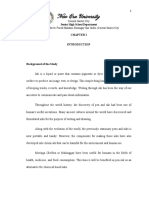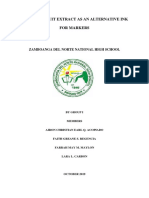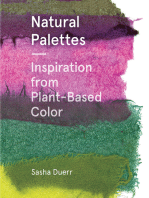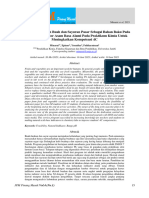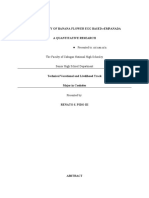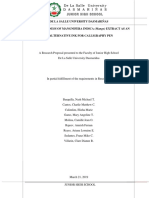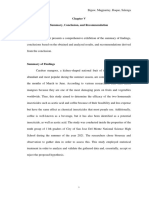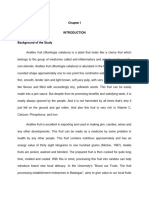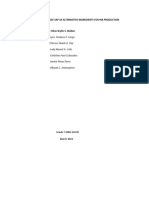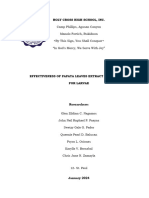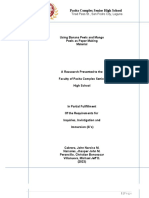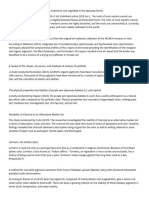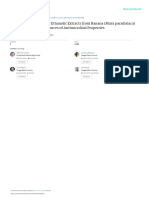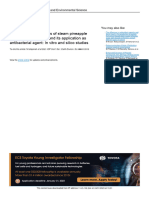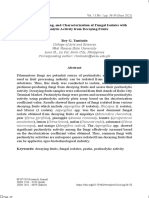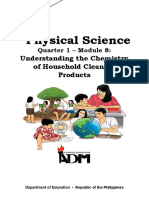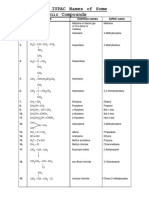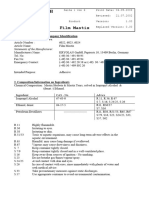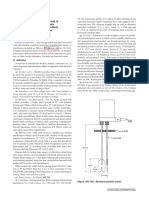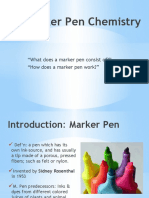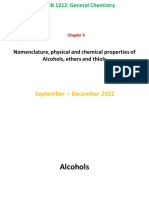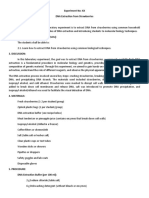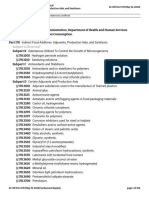Chapter 2
Chapter 2
Uploaded by
Karl FalculanCopyright:
Available Formats
Chapter 2
Chapter 2
Uploaded by
Karl FalculanOriginal Title
Copyright
Available Formats
Share this document
Did you find this document useful?
Is this content inappropriate?
Copyright:
Available Formats
Chapter 2
Chapter 2
Uploaded by
Karl FalculanCopyright:
Available Formats
PATEROS CATHOLIC SCHOOL
Junior High School Department
Pateros, Metro Manila
CHAPTER 2
Related Literatures
Chapter 2
Related Literatures
Jambolan also known as Duhat is rich in several plant constituents such as
anthocyanins, glucoside, ellagic acid, isoquercetin, kaemferol and myrecetin. The seeds
also confirm to contain alkaloids, jambosine, and glycoside jambolin or antimellin. Thus,
studies show that the seeds contain flavonoids, an antioxidant, which is useful in the
prevention of the accumulation of free radicals in the body and acts as a protection
against harmful substances.
Reference: National Center for Biotechnology Information, U.S. National Library
of Medicine8600 Rockville Pike, Bethesda MD, 20894 USA
Anthocyanin Pigments
In a study conducted, the colors of the rinds of Java plum and Mangosteen range
from red to dark purple. These fruits contain anthocyanins which is useful as natural
colorants. In the methods, sugar palm fruit jam was used as the basis for the color
changes of the fruit rinds. Results showed that the rinds of Java Plum and Mangosteen
produced color
Java Plum (Syzgium cumini) as an Alternative Ink for Whiteboard Markers
Presto, Malapit, Granada, Briagas, Tayong (S.Y.; 2019 - 2020)
1
PATEROS CATHOLIC SCHOOL
Junior High School Department
Pateros, Metro Manila
Reference: Rina Yenrina, Kesuma Sayuti and Tuty Anggraini, 2016. Effect of
Natural Colorants on Color and Antioxidant Activity of "Syzgium cumini" (Jambolan
Fruit) Jam. Pakistan Journal of Nutrition, 15: 1061-1066.
Quantitative Evaluation Of Rubus Fruit Anthocyanin Pigments
Another study showed the quantitative evaluation of Rubus fruit anthocyanin
pigments. The distribution of individual anthocyanin pigments in the fruits of
43 Rubus clones was determined by TLC and densitometry.
Reference: Scientific Paper No. 4629. Washington State University, College of
Agriculture Research Center Project 0051.
Determination of Total Monomeric Anthocyanin Pigment Content of Fruit Juices,
Beverages, Natural Colorants, and Wines by the pH Differential Method
A collaborative study was used to determine the total monomeric anthocyanin
concentration using the pH differential method, which is a rapid and simple
spectrophotometric method based on the anthocyanin structural transformation that
occurs with a change in pH (colored at pH 1.0 and colorless at pH 4.5).
Reference: Scientific Paper No. 4629. Washington State University, College of
Agriculture Research Center Project 0051.
Isopropyl Alcohol
Isopropanol, also known as isopropyl alcohol, is another chemical found in dry-erase
markers. Isopropyl alcohol (IPA) is a solvent--a chemical that dissolves other
Java Plum (Syzgium cumini) as an Alternative Ink for Whiteboard Markers
Presto, Malapit, Granada, Briagas, Tayong (S.Y.; 2019 - 2020)
2
PATEROS CATHOLIC SCHOOL
Junior High School Department
Pateros, Metro Manila
substances and mixes with other solvents easily. IPA is found in many household
products, including rubbing alcohol, cleaners, glue, paint and inks. Like most types of
alcohol, isopropanol is highly flammable; never expose dry-erase markers to an open
flame. Inhaling the fumes of a dry-erase marker can cause both long-term and short-
term health hazards, such as irritation to the mucous membranes, confusion and
possibly kidney or liver problems .
Reference: https://sciencing.com/list-6040398-chemicals-dry-erase-markers.html
How to Make Recycled Ink From Fruits
Nature can provide for everyday needs such as writing ink. Traditional ink sources
include flower petals and tree bark, and though fruit sources are less traditional, they also
make for useful ink.
This study aimed to find other chemicals to substitute toxic substances found in
conventional highlighter ink. The study was designed to compare the performace of the
test inks and that of a commercial brand ink. This study was also aimed to test if the inks
will be able and ready to be introduced into the market
Reference: The Complete Book of Herbs"; Lesley Bremness; 1988
Plants that have ink properties
s or a fun, safe ink anyone can use, crush a few berries. Strawberries, raspberries,
blueberries and a variety of other berry fruits are often used to create a wide range of ink
colors, including red or blue.
Reference: Condy, Sienna. "Plants That Have Ink Properties" sciencing.com,
https://sciencing.com/plants-that-have-ink-properties-13428086.html. 2 March 2020.
Java Plum (Syzgium cumini) as an Alternative Ink for Whiteboard Markers
Presto, Malapit, Granada, Briagas, Tayong (S.Y.; 2019 - 2020)
3
PATEROS CATHOLIC SCHOOL
Junior High School Department
Pateros, Metro Manila
Effectiveness of Java Plum as an Natural Colorant
Chemical nature, stability and bioefficacies of anthocyanins from fruit peel of syzygium
cumini Skeels.The high antioxidant activity and relatively high stability of the pigments
make S. cumini a potential source of natural colourant as well as antioxidants.
Reference: Walsh, Elliot. "Effectiveness of Java Plum as an Natural Colorant
sciencing.com, https://sciencing.com/effectiveness-of-Java-Plum-as-an-Natural-Colorant-
724480.html. 2 March 2020.
Extraction of natural anthocyanin and colors from pulp of jamun fruit
In this present study, natural pigment and colors from pulp of jamun fruit were extracted
under different extraction conditions such as extraction temperature (40–60 ˚C), time
(20–100 min) and solid–liquid ratio (1:10–1: 15 g/ml) by aqueous extraction method.
Three factors with three levels Box-Behnken response surface design was employed to
optimize and investigate the effect of process variables on the responses (total
anthocyanin and color.
Reference: National Center for Biotechnology Information, U.S. National Library of
Medicine8600 Rockville Pike, Bethesda MD, 20894 USA
Java Plum (Syzgium cumini) as an Alternative Ink for Whiteboard Markers
Presto, Malapit, Granada, Briagas, Tayong (S.Y.; 2019 - 2020)
4
PATEROS CATHOLIC SCHOOL
Junior High School Department
Pateros, Metro Manila
Java Plum (Syzgium cumini) as an Alternative Ink for Whiteboard Markers
Presto, Malapit, Granada, Briagas, Tayong (S.Y.; 2019 - 2020)
5
You might also like
- Malunggay Leaves As An Alternative Pen InkDocument38 pagesMalunggay Leaves As An Alternative Pen InkAngie Cañete91% (23)
- Alugbati Fruit Extract As An Alternative Ink For Markers2Document16 pagesAlugbati Fruit Extract As An Alternative Ink For Markers2Lara Carbon57% (7)
- Natural Palettes: Inspirational Plant-Based Color SystemsFrom EverandNatural Palettes: Inspirational Plant-Based Color SystemsRating: 4.5 out of 5 stars4.5/5 (4)
- Final Paper - Acceptability of Orange Peel As A Gummy CandyDocument26 pagesFinal Paper - Acceptability of Orange Peel As A Gummy CandyAguilar, Mary Glenn Kyle N.83% (6)
- AhbastaDocument7 pagesAhbastaVena Jezna Libago RecañaNo ratings yet
- Banana Sap As Alternative MarkerDocument14 pagesBanana Sap As Alternative Markerroi abraham matienzoNo ratings yet
- Chapter 1 5 FinalDocument98 pagesChapter 1 5 FinalBety Mae VillagraciaNo ratings yet
- Chapter FiveDocument3 pagesChapter FiveKarl FalculanNo ratings yet
- Limbah Kulit Pisang Sebagai Alternatif Pengganti Pewarna Sintetis Pada Bedak TaburDocument11 pagesLimbah Kulit Pisang Sebagai Alternatif Pengganti Pewarna Sintetis Pada Bedak TaburdestywidiantaraNo ratings yet
- 25408-Article Text-76877-1-10-20230630Document9 pages25408-Article Text-76877-1-10-20230630Edwin CahyadiNo ratings yet
- Republic of The Philippine College of Agricultural Science Ampayon Butuan City, PhilippinesDocument42 pagesRepublic of The Philippine College of Agricultural Science Ampayon Butuan City, PhilippinesBergo Agustin67% (3)
- Research Journal 4Document3 pagesResearch Journal 4Jimmin Jo GorsuchNo ratings yet
- Banana Branch As Permanent InkDocument12 pagesBanana Branch As Permanent Inkivanneclark0724No ratings yet
- Chapter OneDocument4 pagesChapter OneKarl FalculanNo ratings yet
- Chapter 1-3 Finale ThesisDocument63 pagesChapter 1-3 Finale ThesisBety Mae VillagraciaNo ratings yet
- Efficacy of Carica Papaya Enzyme As Antibacterial Hand SanitizerDocument9 pagesEfficacy of Carica Papaya Enzyme As Antibacterial Hand SanitizerAnna Garcia BuquidNo ratings yet
- 2447 6508 1 PBDocument5 pages2447 6508 1 PBYunita Siti MardhiyyahNo ratings yet
- USING MANGOSTEEN RIND AS A PIGMENT IN A MULTIPURPOSE MAKEUP IntroDocument4 pagesUSING MANGOSTEEN RIND AS A PIGMENT IN A MULTIPURPOSE MAKEUP IntroKimberly SisonNo ratings yet
- Share Paubra Ni Maam AizaDocument27 pagesShare Paubra Ni Maam AizaTHIR DEENo ratings yet
- SENSORY-EVALUATION-AS-A-TOOL-IN-DETERMINING-ACCEPTABILITYDocument15 pagesSENSORY-EVALUATION-AS-A-TOOL-IN-DETERMINING-ACCEPTABILITYsaliwagay4No ratings yet
- Canarium Ovatum Engl. (Pili) Exocarp Crude Extract As Functional Food ColorantDocument10 pagesCanarium Ovatum Engl. (Pili) Exocarp Crude Extract As Functional Food ColorantFranco TankNo ratings yet
- Formulasi Sediaan Sabun Cair Kombinasi Ekstrak Etanol DAUN KERSEN (Muntingia Calabura L.) DAN DAUN KEMANGI (OcymumDocument9 pagesFormulasi Sediaan Sabun Cair Kombinasi Ekstrak Etanol DAUN KERSEN (Muntingia Calabura L.) DAN DAUN KEMANGI (Ocymumちかお 千春No ratings yet
- PR 2 Research Paper Group 7.inkDocument4 pagesPR 2 Research Paper Group 7.inkRenz BañezNo ratings yet
- Alugbati and Henna As InkDocument28 pagesAlugbati and Henna As InkMr. Olive OIlNo ratings yet
- Bignay Chap 1 3 2Document22 pagesBignay Chap 1 3 2Ralph AJ BalmesNo ratings yet
- Mondejar, Jr. Arturo BDocument25 pagesMondejar, Jr. Arturo BJulius PrimaNo ratings yet
- Chapter 1-3Document23 pagesChapter 1-3Angeline GamoNo ratings yet
- Aedes Aegypti Which Is The Primary Vector of The Dengue VirusDocument33 pagesAedes Aegypti Which Is The Primary Vector of The Dengue VirusVernice OrtegaNo ratings yet
- Chapter IDocument6 pagesChapter IJohn Arvin RiñenNo ratings yet
- Summary, Conclusion, and RecommendationDocument3 pagesSummary, Conclusion, and RecommendationLovey Ishani TaguinodNo ratings yet
- ARATILESDocument11 pagesARATILESwendellcanon347No ratings yet
- Chloe Brylle S. RoldanDocument6 pagesChloe Brylle S. RoldanChloe RoldanNo ratings yet
- Nutrient Content of BaranganDocument5 pagesNutrient Content of BaranganArzaNo ratings yet
- A Comparative Study of Anthocyanin and C PDFDocument17 pagesA Comparative Study of Anthocyanin and C PDFJhudy PhotNo ratings yet
- Research Paper FreyaDocument7 pagesResearch Paper FreyaAnna Garcia BuquidNo ratings yet
- Cruz Group MRADDocument3 pagesCruz Group MRADJanet Floreno VillasanaNo ratings yet
- Insecticidal Effect of BananaDocument31 pagesInsecticidal Effect of BananaKristine Jill Fuentes LlegueNo ratings yet
- Data in BriefDocument10 pagesData in BriefeaeNo ratings yet
- Research CompilationDocument12 pagesResearch CompilationBearish PaleroNo ratings yet
- Potential of Rambutan (Nephelium Lappaceum) Peel As Herbal BeverageDocument6 pagesPotential of Rambutan (Nephelium Lappaceum) Peel As Herbal BeverageSeptilia DeliaNo ratings yet
- Research OutlineDocument42 pagesResearch OutlineJhasper John NarsolesNo ratings yet
- Research OutputDocument21 pagesResearch OutputBenjie MoralesNo ratings yet
- AMPALAYA (Momordica Charantia) LEAVES EXTRACT As An Alternative MolluscicideDocument28 pagesAMPALAYA (Momordica Charantia) LEAVES EXTRACT As An Alternative MolluscicideSchievvie AbanillaNo ratings yet
- RRL g12Document2 pagesRRL g12gonzales.irishshaneNo ratings yet
- Ink PaperDocument8 pagesInk PaperPriyanka PatilNo ratings yet
- PR Group2Document17 pagesPR Group2Renz John AgcaoiliNo ratings yet
- IJB Vol 21 No 1 P 169 183Document16 pagesIJB Vol 21 No 1 P 169 183lorrainesarian08No ratings yet
- 15 fr-2019-060 Siti Rashima 8Document10 pages15 fr-2019-060 Siti Rashima 8Nur Ahmad Indragiri YardiNo ratings yet
- 27421Document9 pages27421annsero5No ratings yet
- Istiqomah 2021 IOP Conf. Ser. Earth Environ. Sci. 886 012019Document20 pagesIstiqomah 2021 IOP Conf. Ser. Earth Environ. Sci. 886 012019aisyahNo ratings yet
- Fiber ContentDocument5 pagesFiber ContentDiyah DiyahNo ratings yet
- Cruz Group MRADDocument5 pagesCruz Group MRADJanet Floreno VillasanaNo ratings yet
- Research Final 1Document28 pagesResearch Final 1Geralyn FernandezNo ratings yet
- Jackfruit Seed - A Novel Substrate For The ProductiDocument9 pagesJackfruit Seed - A Novel Substrate For The ProductiSofia Dinorah Garcia RendonNo ratings yet
- Characterization and Quantification of Individual Betalain and Phenolic PDFDocument13 pagesCharacterization and Quantification of Individual Betalain and Phenolic PDFAlphonseNo ratings yet
- Isolation Screeningand Characterizationof Fungal Isolateswith Pectinolytic Activityfrom Decaying FruitsDocument15 pagesIsolation Screeningand Characterizationof Fungal Isolateswith Pectinolytic Activityfrom Decaying FruitsPler WiezNo ratings yet
- The Effectiveness of MangosteenDocument5 pagesThe Effectiveness of MangosteenAnalyn PinuelaNo ratings yet
- Chapter-1 & 2-SampleDocument16 pagesChapter-1 & 2-Samplejustine caintoyNo ratings yet
- Pesticides Environmental Destination: A Study Based On Coffee Productive AreasFrom EverandPesticides Environmental Destination: A Study Based On Coffee Productive AreasNo ratings yet
- SSHE-106-GDL-569 Medical Surveillance Management Guideline Rev.0Document47 pagesSSHE-106-GDL-569 Medical Surveillance Management Guideline Rev.0Isnain RahmatNo ratings yet
- 15 Exam III PracticeDocument12 pages15 Exam III PracticeidaayudwitasariNo ratings yet
- MSDS AlcoholDocument6 pagesMSDS AlcoholRajaIshfaqHussain100% (1)
- Corzan Chemical Resistance Data BrochureDocument8 pagesCorzan Chemical Resistance Data BrochureamlanfacebookNo ratings yet
- Physical Science Q1 Module 8Document20 pagesPhysical Science Q1 Module 8Crispulo Arquero IIINo ratings yet
- Common Name RDocument7 pagesCommon Name Rrickreacher4No ratings yet
- Film MastixDocument6 pagesFilm MastixDudley DoomNo ratings yet
- Desinfectants and AntisepticsDocument14 pagesDesinfectants and AntisepticsAri Sri WulandariNo ratings yet
- Safari 6 Aug 2020 at 857 AM PDFDocument1 pageSafari 6 Aug 2020 at 857 AM PDFCamille MagdirilaNo ratings yet
- 16.1.01 AOAC Official Method 945.75 Extraneous Materials (Foreign Matter) in ProductsDocument4 pages16.1.01 AOAC Official Method 945.75 Extraneous Materials (Foreign Matter) in ProductsMiguel VNo ratings yet
- Marker Pen ChemistryDocument11 pagesMarker Pen ChemistryRiel TanyagNo ratings yet
- Master Harga SaraswantiDocument12 pagesMaster Harga SaraswantiArreza Hamsyah FernandaNo ratings yet
- Operating Instructions - Iqam - GB - 2019-11 - Vers01Document32 pagesOperating Instructions - Iqam - GB - 2019-11 - Vers01Trâm NguyễnNo ratings yet
- The Feasibility of Orange (Citrus Sinensis) Fruit Peel and Isopropyl Alcohol As A BalmDocument18 pagesThe Feasibility of Orange (Citrus Sinensis) Fruit Peel and Isopropyl Alcohol As A BalmArlene Castor AguilaNo ratings yet
- Group 3 - Acetone Production Via The Dehydrogenation of IPADocument7 pagesGroup 3 - Acetone Production Via The Dehydrogenation of IPAQuỳnh Như PhạmNo ratings yet
- Toxicology: Clinical Chemistry 3Document78 pagesToxicology: Clinical Chemistry 3Jovelyn Destreza CachoNo ratings yet
- Ch. 6 Nomenclature, Physical and Chemical Properties of Alcohols, Ethers and ThiolsDocument61 pagesCh. 6 Nomenclature, Physical and Chemical Properties of Alcohols, Ethers and ThiolsCollo KarisNo ratings yet
- What Happens When Hydrochloric Acid & Sodium Thiosulphate ReactDocument6 pagesWhat Happens When Hydrochloric Acid & Sodium Thiosulphate ReactAzel OthmanNo ratings yet
- Chemical Product List - Smart Lab-MSIDocument4 pagesChemical Product List - Smart Lab-MSIGandi Sogandi100% (1)
- Assigment-Hydroxy Compounds FOR AIEEEDocument41 pagesAssigment-Hydroxy Compounds FOR AIEEEApex Institute100% (1)
- Isolation of Alkaloids From Plants................Document28 pagesIsolation of Alkaloids From Plants................anjali singh bijyal100% (1)
- Isopropyl Alcohol (IPA) - Chemical Economics Handbook (CEH) - IHS MarkitDocument5 pagesIsopropyl Alcohol (IPA) - Chemical Economics Handbook (CEH) - IHS MarkitarmanNo ratings yet
- Nail Polish FormulaDocument15 pagesNail Polish Formularajesh kothariNo ratings yet
- DNA Extraction From StrawberriesDocument5 pagesDNA Extraction From StrawberriesCharles MayoNo ratings yet
- Industrial Experience in Using Cyclic Distillation Columns For Food Grade Alcohol PurificationDocument8 pagesIndustrial Experience in Using Cyclic Distillation Columns For Food Grade Alcohol Purificationmontse2002mglNo ratings yet
- 21 CFR Part 178 (Up To Date As of 5-10-2024)Document166 pages21 CFR Part 178 (Up To Date As of 5-10-2024)Mariane KaiNo ratings yet
- Chapter - 4: Material Balance BasisDocument11 pagesChapter - 4: Material Balance BasisFahad KhokharNo ratings yet
- 000t DC Solvents MsdsDocument3 pages000t DC Solvents MsdsFaldiNo ratings yet
- (Thiol Mercaptan) Sulfur in Gasoline, Kerosine, Aviation Turbine, and Distillate Fuels (Potentiometric Method)Document8 pages(Thiol Mercaptan) Sulfur in Gasoline, Kerosine, Aviation Turbine, and Distillate Fuels (Potentiometric Method)indra defistaNo ratings yet
- P3 - Toxi Post TestDocument12 pagesP3 - Toxi Post TestSaeed BaltNo ratings yet
